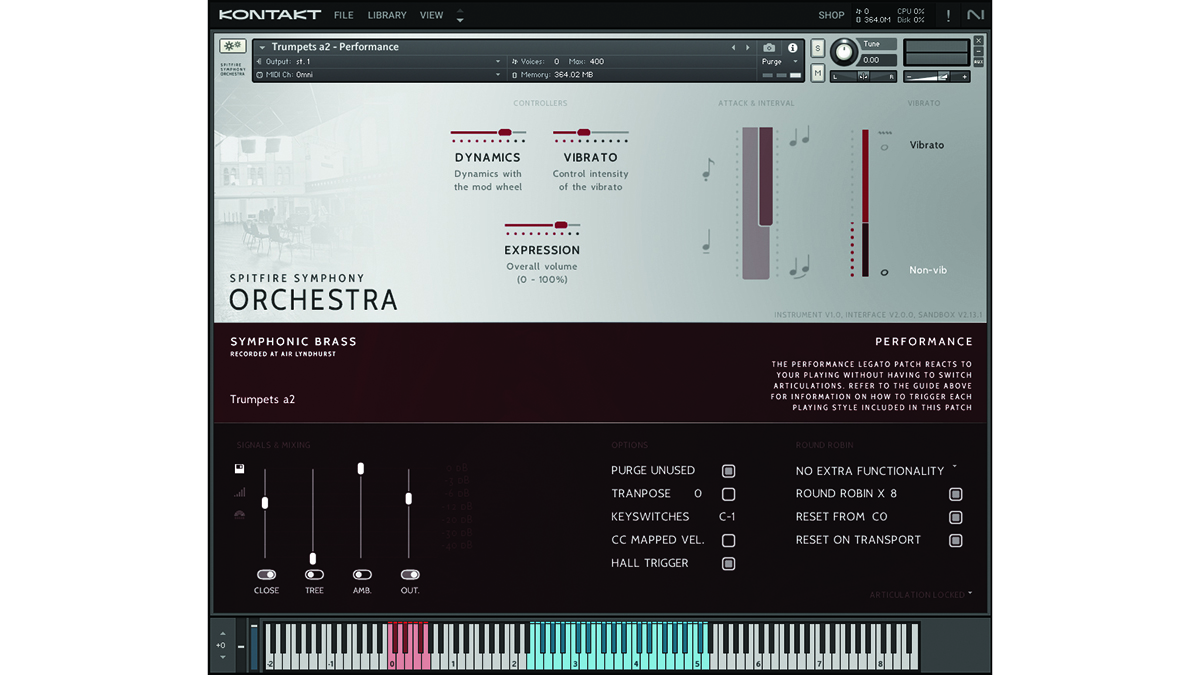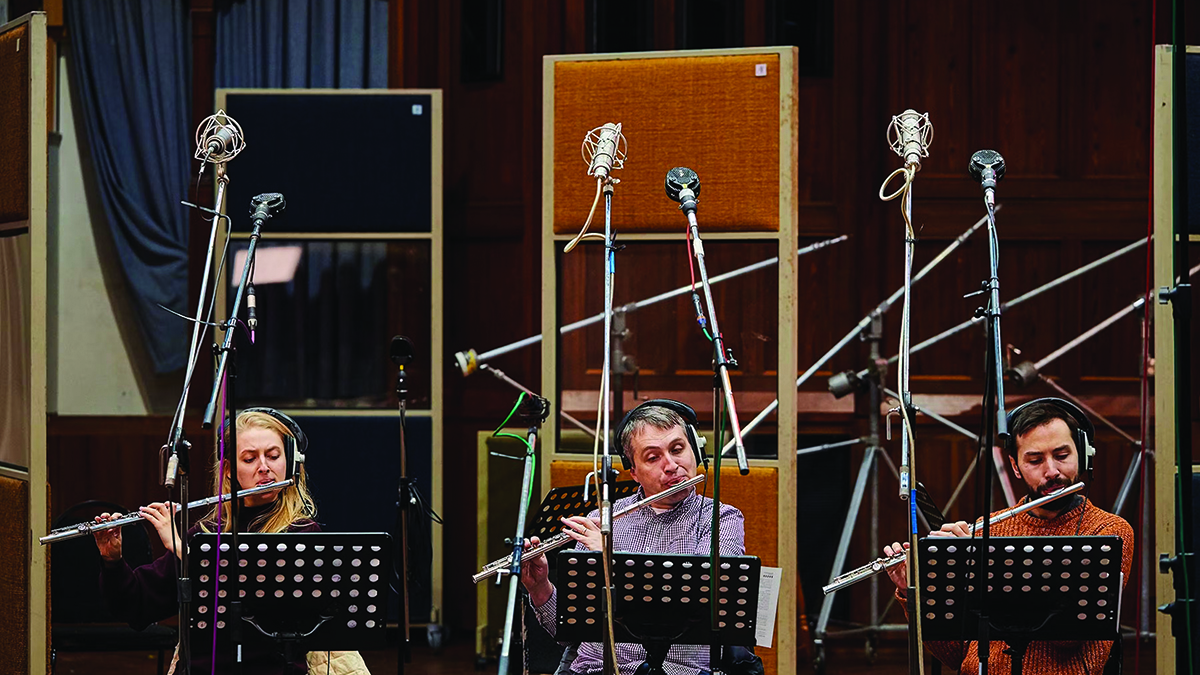MusicRadar Verdict
This is less a refresh and more a redesign with considerable additions. Attractively priced and highly usable, it’s about as good as it gets for an orchestral library.
Pros
- +
Extensive orchestral sample library
- +
All orchestral sections included, with some very welcome extended instrumentation in there
- +
Newly designed GUI with streamlined articulation access
- +
The performance legatos are very playable and impressive
- +
The package price has dropped… enormously at that!
Cons
- -
Some instrument samples require more work-in-use than others
MusicRadar's got your back
Spitfire Audio Spitfire Symphony Orchestra: What is it?
There’s nothing quite like the sound of a full symphony orchestra. The sound of 100 musicians playing as an ensemble has long been the preserve of classical composers, with the modern symphony orchestra continuing to play an enormous part in productions of all forms, from string sections in your favourite pop ballad, to the full-on onslaught of a battle sequence in a feature film or video game. With developments in sampling tech, you can strike up the virtual band and create a pretty convincing facsimile, at a fraction of the cost of the real thing.
Spitfire Audio is undoubtedly one of the leading lights in this pursuit. Established by two media composers, they went from selling their home-made orchestral library to friends, to the inauguration of their own company, in quick succession. Under the guise of Spitfire Audio, a long-running relationship was established with AIR Studios, from its earliest sampling days. This provided a location for its original BML sample library, which offered the purchase of individual instruments and sections. It was quite costly, which might explain why most of these samples were quickly combined to create the original Spitfire Symphonic library, which has now morphed into the Spitfire Symphony Orchestra.
This latest incarnation sees a further refresh to these samples, but with a considerable number of alterations and additions, along with a huge drop in price. One of the most significant points to address is that SSO remains a Native Instruments Kontakt-based library; Spitfire has included its own proprietary player within a number of its more recent releases, as a prerequisite format. It’s fair to say that users’ reception to the player, included with libraries such as Hans Zimmer Strings and BBCSO, has been somewhat mixed. It lacks multi-timbral operation and demonstrates relatively slow loading times. Kontakt, on the other hand, is a proven performer. Now at version 7, it provides a number of useful functions with some welcome new eye-candy.

Spitfire Audio Spitfire Symphony Orchestra: Performance and verdict
Although many of the samples have been redeployed from the good ol’ days, they still sound as fresh as ever. A newly designed and streamlined Kontakt GUI combines many of the old instrument presets into a single pane. Consequently, you can place vast numbers of articulation into a single Kontakt instrument, although the Legato articulations still operate as a separate instrument entity.

• Audio Imperia Jaeger
A superb collection for modern scoring, with the most sublime instruments and vocal samples.
• Cinematic Studio Series Strings, Brass & Woodwinds
One of the most advanced and responsive orchestral libraries available, though currently lacking a percussion section.
In fact, the Legato patches have undergone a significant make-over, in collaboration with composer Andrew Blaney. In a slight nod to some other orchestral package legatos, the Performance instrument provides plenty of control, with a handy graphic that displays how your legato playing is affecting the musical phrasing.
Delving a little deeper into the components, SSO loads as a single Kontakt library. Within this new Kontakt instrument format, a drop-down menu at the top of the instrument list allows a more focused selection of your chosen sound.
Apart from the more common instrumental sections, Spitfire has included additional components for flexible working. Getting ideas down quickly is pretty essential when working orchestrally, and this is where the Curated Ensemble patches come into their own. With a full instrumental ensemble patch for strings, brass, winds, or all three together as a Tutti, these instruments provide instant gratification, as a just-record-and-go option. You can always return later to orchestrate your idea conventionally, across the five instrument sections on offer.
Want all the hottest music and gear news, reviews, deals, features and more, direct to your inbox? Sign up here.
It’s also fair to say that the Ensemble patches could go a long way to provide the spirit and colour that you might need for your production, so if you’re used to playing like a pianist at the keyboard, you can introduce immediate orchestral colour with a minimum of hassle. Moreover, there are a number of patches within each ensemble section that provide everything from subtle nuance to full-on dynamic extremity. The usual dynamic control is also available via MIDI CC and the modulation wheel.
Many bows
As we’re long-time users of all of the previous incarnations of this Spitfire library, it’s interesting to note how easy this version is to work with. In the case of the strings, the extensive set of articulations are presented through five string instruments, from 1st and 2nd violins through to double basses, which can also be loaded in a number of different incarnation. The All Techniques patch is your one-stop-shop for all articulations other than Legato. You can also load the lesser Core Techniques or the Decorative patch options, but having this flexibility allows you to work to your computer’s RAM capabilities. Whichever your scenario, all articulations can be key-switched or manually selected from the GUI.
With a total of 60 string players recorded as an orchestral ensemble, Spitfire includes five microphone positions. Each of these can be disabled or bought into play to suit your production style. Revisiting many of these sounds reminded us how useful it is to have this operational detail to hand. It can sometimes sound as though the strings are emerging in what we often refer to as the ‘toothpaste tube’ effect, but with some subtle mixing of microphone signal, combining close and distant signals, it is possible to improve the musicality of phrase considerably.
Elsewhere, the combination of long notes and some very biting short and percussive articulations, provide an exceptionally extensive palette, which will easily satisfy the most ardent of composers.

Take a breath
The Wind and Brass sections offer an equally extensive array of articulations. Adopting the same construct as the strings, instrument patches may be loaded individually with all techniques in play, with the exception of legato, which needs to be loaded separately as a Performance patch. This can be where the usefulness of the multi-timbral Kontakt format pays dividends.
The wind section includes the four main wind instruments, alongside useful additions from alto flute, bass clarinet, contrabass clarinet, cor anglais, piccolo and contrabassoon. With contemporary and media scoring in mind, this extended instrumentation proves inviting.
We have even seen trumpet players weep, so convincing is the Performance Legato a2 Trumpet patch!
Meanwhile, the SSO brass section remains one of the best we’ve ever heard. Brass instruments can be exceptionally difficult to capture, but the range of dynamics, coupled with some exceptionally useful microphone placement, makes the brass section feel engaging. The instrumentation ranges from solo performances, through to 2-player and even 6-player renditions. The Performance Legato a2 Trumpet patch has to be heard to be believed. We have even seen trumpet players weep, such is its convincing nature!

New edition additions
Notable additions to this new version of SSO include piano, harp, and most useful of all, a percussion collection containing 63 different tuned and untuned instruments. Internationally renowned percussionist, Joby Burgess, has provided the content here, and convincingly so. Included instrumentation ranges from field drums and snares, through to cymbals and sleigh bells. It’s safe to say that just about any percussion instrument you will care to name is here, including an anvil.

AIR versus the Abbey
One of the most contentious points, across all orchestral sample libraries, relates to the acoustic of the venue for sample capture. User preference is often informed by the style of music production. Media, film and game composers often prefer the drier acoustic of a soundstage, which is specifically designed to limit reflection of sound, resulting in less reverberation within the sample capture itself. This allows composers and producers to apply their own reverberation effects, rather than play host to the samples themselves. Consequently, Abbey Road studios and other soundstage venues continue to be popular, and some composers distinctly prefer it to a more reverberant setting.
The Great Hall at AIR Lyndhurst offers a degree of balance between a nice acoustic and acceptable control, being acoustically forgiving and reasonably bright. As SSO offers the ability to zone in on the source sample, it could be regarded as a good representation of the best of both worlds. Thanks to the generosity of five distinct microphone channels, it is possible to engineer a sound that works for you, without needing to leave your DAW or Kontakt instrument. It’s always nice to have the choice, and that’s certainly the proviso here.

Encore
In all the years that Spitfire has been curating its catalogue, we’ve often thought that its earlier libraries remained unsurpassed. This makes this release all the more tempting, as it allows us to rediscover the quality of those sounds, while providing a beautiful new setting which allows us to get at the content very easily. The older content nestles alongside plenty of new material, with the Performance Legato elements receiving an extensive redesign. At a whopping 345GB, this is an enormous sample-based tome, at a price which is difficult to ignore, being a total bargain.
MusicRadar verdict: This is less a refresh and more a redesign with considerable additions. Attractively priced and highly usable, it’s about as good as it gets for an orchestral library.
Spitfire Audio Spitfire Symphony Orchestra: The web says
"The recording quality, sheer number of articulations, and the new price point all contribute to presenting Spitfire Symphony Orchestra with one of the best quality-to-price ratios in the market today."
Epicomposer
Spitfire Audio Spitfire Symphony Orchestra: Hands-on demos
Spitfire Audio
Guy Michelmore
The Sampleist
Spitfire Audio Spitfire Symphony Orchestra: Specifications
- macOS 11, 12 or 13 (latest update). Intel Macs (i5 or higher). Apple Silicon Macs (Natively and via Rosetta in hosts that require this)
- Windows 10 and 11. Intel Core i5 or equivalent CPU
- 4GB RAM (6GB recommended for large Kontakt Instruments)
- CONTACT: Spitfire Audio
Roland Schmidt is a professional programmer, sound designer and producer, who has worked in collaboration with a number of successful production teams over the last 25 years. He can also be found delivering regular and key-note lectures on the use of hardware/software synthesisers and production, at various higher educational institutions throughout the UK




